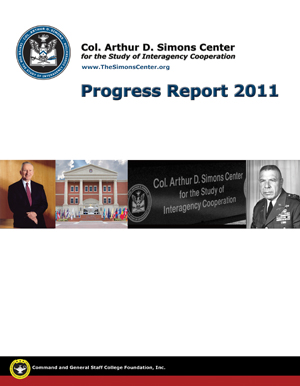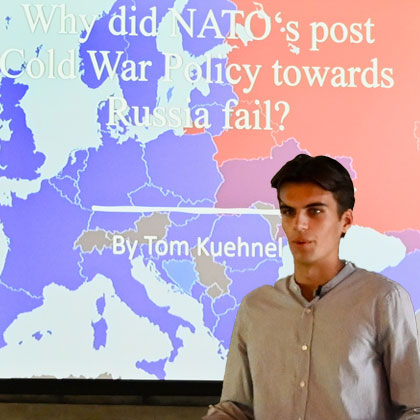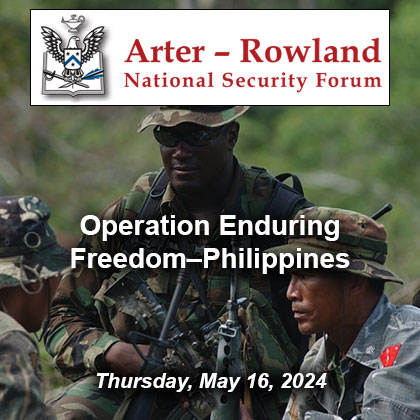Simons Center Progress Report for 2011
by Theodore E. Strickler
Executive Director
People frequently ask why the Col. Arthur D. Simons Center for the Study of Interagency Cooperation is located at Fort Leavenworth, Kansas, instead of Washington, D.C. Given that our mission is to study, investigate and analyze interagency issues at the operational and tactical levels of effort, not the strategic level, being headquartered outside of the nation’s capital makes sense.
Washington, D.C. is all about strategy and policy. While the policymakers in government hammer out policies, they most often look to those in the field to implement them. Our nation’s involvement in Iraq and Afghanistan illustrate this point. The location at Fort Leavenworth provides the Simons Center with the physical and the intellectual distance needed to remain fixed on the operational and tactical levels of interagency issues without being sidetracked by policy debates. Simply put, our mission is to improve how policy is implemented, not how it is made. Our location at Fort Leavenworth, and links with the U.S. Army’s Command and General Staff College — which stresses operations and tactics – helps us retain our distinctive mission focus.
Orchestrating all the moving parts of government to operate in a coordinated, harmonious fashion is, indeed, a daunting undertaking. But we believe targeted and specific programs such as those run by the Simons Center can make a difference. In 2011 we expanded several programs and initiated others to fulfill our mission to help bridge persistent gaps in the government’s ability to function in a truly coordinated manner.
First, we recognized the need for a comprehensive understanding of all aspects of interagency coordination. To meet that basic requirement, we expanded our efforts to establish a body of interagency knowledge by publishing two issues of the InterAgency Journal (February and August) as well as a total of ten issues of our InterAgency Paper and InterAgency Essay series.
Complementing our efforts to publish new and creative thinking about interagency activities, Elizabeth Hill, our Program Assistant, researched and compiled a comprehensive interagency bibliography containing more than 800 entries listing interagency related articles and documents, professional commentary by subject matter experts, and academic research from both military and nonmilitary institutions, including reports from the Government Accountability Office and the Congressional Research Service. This bibliography is a significant addition to the overall body of interagency knowledge which the Simons Center will continue to grow and expand.
Second, we worked to help develop leaders with the right combination of skills, education and training to be able to work effectively in situations requiring interagency cooperation. One such program was the conference on Transition Issues in Iraq and Afghanistan which we cosponsored with the Army’s Combined Arms Center and the U.S. Institute for Peace. This conference, held in Washington, D.C. in February, examined interagency transition issues during the change from military to civilian led operations in the two countries. The insights and guidance gained from this conference were compiled and published by the Simons Center in October as a handbook for senior military and civilian leaders.
Third, we supported congressional efforts to improve the government’s ability to operate more effectively on matters requiring interagency coordination. The Simons Center endorsed legislation introduced by Senators Lieberman and Collins that seeks to improve the qualifications of career civil servants being promoted into Senior Executive Service (SES) positions. As a result of discussions with key staff members about ways to improve the bill’s various provisions, several Simons Center suggestions eventually were adopted and are reflected in the bill (S. 1268). In addition, the bill highlights the CGSC Foundation’s Simons Center by name as a specific example of organizations to be consulted in establishing a coordinating committee to implement and administer the bill’s directives.
Fourth, in order to promote scholarship and research on interagency topics, the Simons Center sponsored several writing competitions during the year. At the Command and General Staff College’s June graduation ceremony, Foundation Chairman Lt. Gen. (Ret.) Robert Arter presented Tyron Cunningham, U.S. Marshals Service with the Simons Center’s first interagency writing award for CGSC students. In September, we announced an interagency writing competition open to the general public. Later that same month we named Dr. Nathan W. Toronto, School of Advanced Military Studies, Command and General Staff College as the winner of our faculty writing competition. Second place was awarded to Dr. William J. Davis, Department of Joint Interagency and Multinational Operations at the Command and General Staff College.
Fifth, to help expand our reach and capabilities, we established a student internship program and selected Sean Webeck from Kansas State University as our first student intern. Sean served in the U.S. Army and is now pursuing a graduate degree in National Security Studies. As a student intern at the Simons Center, he is researching topics to be included in an eventual interagency textbook by interviewing academic experts and government officials. The internship program with Kansas State University was made possible with strong support from Dr. Carol Shanklin, Dean of Graduate Studies; Cheryl Polson, Associate Dean; and Professors David Stone and Jeff Pickering. Based on discussions with Dr. Jerry Jorgensen, Park University Provost, and the Deans’ Council, we established a similar student internship program with Park University. We have also had preliminary discussions with University of Kansas officials and anticipate setting up similar internship programs with that academic institution as well.
Finally, we looked to the future and began planning for the programs and projects that will help to advance our goals and objectives in 2012 and beyond. In that regard, we began initial work on a biography of Col. Arthur “Bull” Simons, our center’s namesake. When published, this book will celebrate the life and legacy of a professional warrior whose fierce courage and determination in the face of overwhelming odds continues to be admired and celebrated today.
We will expand our outreach programs to include a greater number of individuals from the Air Force, Navy and Marines as well as civilian departments and agencies such as Justice, Treasury and Homeland Security. And we will continue to keep an eye on interagency developments on Capitol Hill, seeking to have our voice heard in helping to shape those developments.
Ever mindful of the financial requirements needed to sustain the Simons Center’s unique mission and important contribution to improving the government’s ability to operate in a truly coordinated manner, we will seek those grants and other funding sources that will help reach the Simons Center’s goal of becoming the premier, nationally recognized center of interagency research and knowledge.
We have an ambitious agenda to help alleviate chronic coordination shortcomings throughout government. We are encouraged by those who enthusiastically support our efforts and pledge to work even more diligently to make well-coordinated interagency cooperation the rule, not the exception.
For the complete progress report for 2011, please follow the link below.
Col. Arthur D. Simons Center Progress Report 2011

Posted: December 19, 2011 by Simons Center
READ THE LATEST UPDATES FROM THE SIMONS CENTER
"*" indicates required fields


